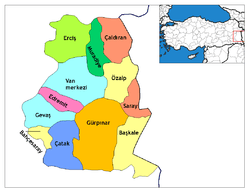Van Province
| Van Province Van ili | |
|---|---|
| Province of Turkey | |
 Location of Van Province in Turkey | |
| Country | Turkey |
| Region | Central East Anatolia |
| Subregion | Van |
| Government | |
| • Electoral district | Van |
| Area | |
| • Total | 19,069 km2 (7,363 sq mi) |
| Population (2010-12-31)[1] | |
| • Total | 1,035,418 |
| • Density | 54/km2 (140/sq mi) |
| Area code(s) | 0432[2] |
| Vehicle registration | 65 |
Van Province (Turkish: Van ili) is a province in eastern Turkey, between Lake Van and the Iranian border. It is 19,069 km2 in area and had a population of 1,035,418 at the end of 2010. Its adjacent provinces are Bitlis to the west, Siirt to the southwest, Şırnak and Hakkâri to the south, and Ağrı to the north. The capital is the city of Van. The majority of the province's population is Kurdish.[3]
Districts
History
This area was the heartland of Armenians, who lived in these areas from the time of Hayk in the 3rd millennium BCE right up to the late 19th century when the Ottoman Empire seized all the land from the natives.[4] In the 9th century BC the Van area was the center of the Urartian kingdom.[5] The area was a major Armenian population center. The region came under the control of the Armenian Orontids in the 7th century BC and later Persians in the mid-6th century BC. By the early 2nd century BC it was part of the Kingdom of Armenia. It became an important center during the reign of the Armenian king, Tigranes II, who founded the city of Tigranakert in the 1st century BC.[6] With the Seljuq victory at the Battle of Malazgirt in 1071, just north of Lake Van,[7] it became a part of the Seljuq Empire and later the Ottoman Empire during their century long wars with their neighboring Iranian Safavid arch rivals, in which Selim I managed to conquer the area over the latter. The area continued to be contested and was passed on between the Ottoman Empire and the Safavids (and their subsequent successors, the Afsharids and Qajars) for many centuries afterwards, all the way up to during the 19th century.
Gallery
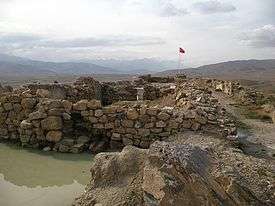 Haykaberd or Çavuştepe
Haykaberd or Çavuştepe.jpg)
- Muradiye Fall
- Medieval Armenian monasteries in the Van Province
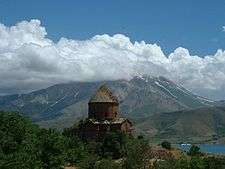 The Armenian Cathedral of the Holy Cross (10th century) on Akdamar Island
The Armenian Cathedral of the Holy Cross (10th century) on Akdamar Island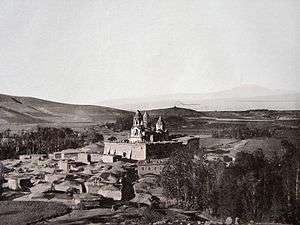 The Armenian Monastery of Narek (10th century)
The Armenian Monastery of Narek (10th century) Varagavank Armenian monastery (11th century)
Varagavank Armenian monastery (11th century)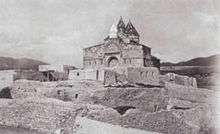 The Armenian Monastery of Saint Bartholomew (13th century)
The Armenian Monastery of Saint Bartholomew (13th century)
- Islamic monuments in the Van Province
 Ruined Ottoman mosque in the old ruined part of Van city (16th century)
Ruined Ottoman mosque in the old ruined part of Van city (16th century)- Tomb of Halime Hatun in Gevaş (14th century)
 Ruined Ottoman minaret in the old part of Van city
Ruined Ottoman minaret in the old part of Van city
See also
| Wikimedia Commons has media related to Van Province. |
Notes
- ↑ Turkish Statistical Institute, MS Excel document – Population of province/district centers and towns/villages and population growth rate by provinces
- ↑ Area codes page of Turkish Telecom website (Turkish)
- ↑ Watts, Nicole F. (2010). Activists in Office: Kurdish Politics and Protest in Turkey (Studies in Modernity and National Identity). Seattle: University of Washington Press. p. 167. ISBN 978-0-295-99050-7.
- ↑ Hofmann, Tessa, ed. (2004). Verfolgung, Vertreibung und Vernichtung der Christen im Osmanischen Reich 1912-1922 [Persecution, Expulsion and Annihilation of the Christian Population in the Ottoman Empire 1912-1922]. Münster: LIT. ISBN 3-8258-7823-6.
- ↑ European History in a World Perspective - p. 68 by Shepard Bancroft Clough
- ↑ The Journal of Roman Studies – p. 124 by Society for the Promotion of Roman Studies
- ↑ Melissa Snell. "Alp Arslan: Article from the 1911 Encyclopedia". About Education.
External links
Coordinates: 38°29′57″N 43°40′13″E / 38.49917°N 43.67028°E
